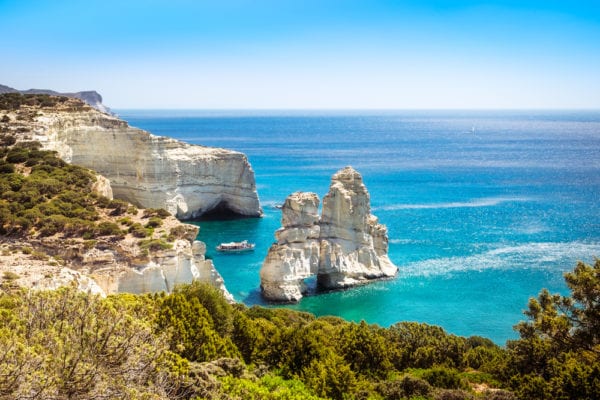Sun, sea and sky: a scenic tour of Aphrodite’s Tears
Sun, sea and sky: a scenic tour of Aphrodite’s Tears
Sun, sea and sky: a scenic tour of Aphrodite’s Tears
-
Hannah
-
Hannah

Sun, sea and sky: in Ancient Greek mythology, each had its own god. Poseidon was the god of the sea, Apollo was the sun god, and mighty Zeus was the god of the sky (and everything beneath it).
As I wrote my novel Aphrodite’s Tears, I had Aphrodite, goddess of love, in mind, of course – but also these other deities and their domains. Because it is impossible to dream of the Greek islands without seeing the bluest sea, the brightest sun and the biggest sky, cerulean or star-sprinkled.
Today, I’m taking you on a tour of the scenery in Aphrodite’s Tears, where the echoes of these ancient gods remain.
Poseidon’s legendary sea
The heroine of Aphrodite’s Tears, Oriel, comes to the island of Helios to work as an archaeologist supervising the exploration of an old shipwreck found on the ocean bed. Helios is a tiny, privately owned island in the Ionian Sea, among Corfu, Kefalonia, Zakynthos, Lefkada and Ithaca. According to mythology, this sea was named for Io, a mortal lover of Zeus.
Here is Oriel’s first time gazing upon the ocean that surrounds Helios:

The night before she hadn’t noticed the small terrace adjoining her bedroom, which had steps leading down to an area of flat rocks. It was a blue morning and the air was still fresh.
Leaning over the parapet, Oriel glanced down at the narrow sandy beach that seemed to border the edge of the property uninterruptedly; from here she could see the crystalline water and the uneven seabed visible beneath it, diapered with long weedy patches, fragments of fallen rock and brighter patches of sand. She inhaled the pungent odour of sea wrack on the sand and listened to the breathing of the waves, which lapped softly against the shore like a herd of nodding mythological beasts emerging from the deep.
To her right, Oriel could see the garden in which she had walked last night. In daytime, the clumps of tall trees with their glossy green foliage and colourful flowers stood motionless in the warm air, with that peculiar entranced appearance leaves and blossoms take on under the sunshine. Beyond the garden was the terrace with its steps that led to a stone wharf, where a long quay jutted out into the sea. The view in front of her held a vision of mythological splendour; here was a landscape where one could imagine the omniscient acts of divine beings, the spilling of golden plenty and the thunderbolt of punishment. This was a legendary sea, steeped in age and tales of heroic voyages. It was difficult not to look around and think: anything can happen here …
Apollo’s dying sun
The leader of Helios, Damian – the man who has employed Oriel, and who quickly tries to win her heart – takes her on his boat to Santorini, an island in the Aegean Sea. There, they climb to Sunset Serenade point, high up in the village of Oia, to watch Apollo pull the sun below the horizon, daubing the sky and the white houses of Oia with all the shades of an artist’s palette.

The setting was perfect: the sky was flushing from blue to lavender as the time of sunset drew near. Here, at the top of the cliffs, the heat was fading to an agreeable coolness as the day began to decline. A smouldering warmth lay upon the sea, which looked like beaten gold in the light of the dying sun.
…
Long tongues of fire spread from the sun’s dazzling rays over the twisted rocks, the houses of the beautiful white town ablaze with a transparent copper glow that reminded her of barley sugar. Smouldering, the molten flames in the sky moved further, changing its smooth azure to violet streaked with apricot, to apple green blending into scarlet, bright yellow and cobalt blue. Within this veil of complex, glorious colour, the golden globe seemed alive with a magnificent sort of agony. Suddenly it faltered, tumbling down behind the horizon – a burning death. The drama and the splendour of it all filled Oriel with a wistful emotion.
Zeus’s timeless starry night
My hero and heroine in Aphrodite’s Tears first meet several years before Oriel comes to Helios, on a lonely beach one evening. The sky that night, I write, was ‘a velvet-dark tapestry, illuminated by a full moon that cast a breathtaking staircase of light on a midnight-blue sea; a night for lovers’ meetings, not for goodbyes’. When Oriel and Damian are reunited, the night sky takes them back to that first night of passion, and the stars seem to have a dazzling significance.

‘There’s a wonderful view from here,’ Damian said, standing aside to let her past and, as Oriel stepped on to the terrace, the breath caught in her throat and she blinked in disbelief. It was as if she were standing on the deck of a boat with the sea stretching into infinity. She looked up at the sky. These were the same stars that greeted the ancients, the same that would be here in millions of years’ time. It must have been a night just like this that inspired Van Gogh, she thought.
‘Incredible,’ she murmured. ‘An absolutely beautiful sight.’
Damian appeared beside her. ‘The stars of Helios are unusual, so close they look like they can be plucked from the night sky.’ He leaned on the balcony, staring into the night. ‘The saying goes that each star is a lover’s dream, and when a star falls out of the heavens…’
Damian is interrupted, his words cut off. What does happen when a star falls from heaven? Does the lover’s dream come true?
Can Zeus and Aphrodite reach an accord in order to bring together these lovers?